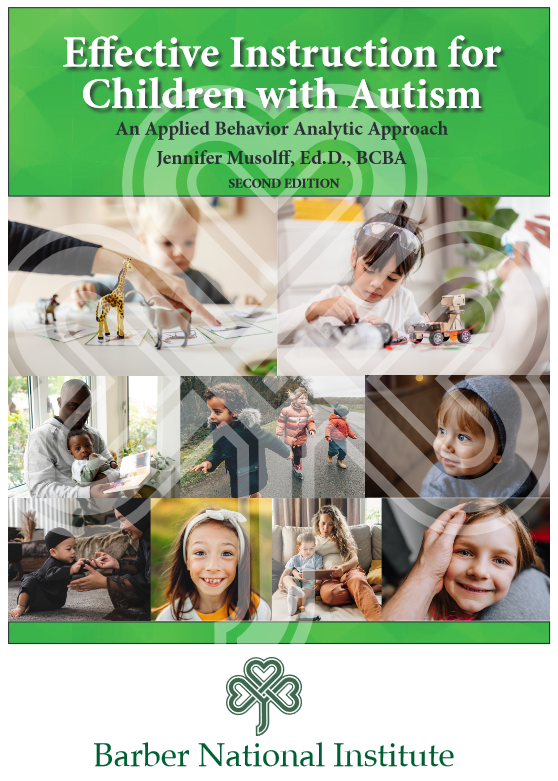
Effective Instruction for Children with Autism: An Applied Behavior Analytic Approach - 2nd Edition
By Jennifer Musolff, Ed.D, BCBA
With Effective Instruction for Children with Autism, there is help and hope for parents, caregivers and teachers working to improve the lives and learning experience of children with autism. This manual, written by a behavior analyst, provides the guidance and support necessary to make a real difference in the treatment of children with autism spectrum disorders.
This second edition includes more recent resources and references and additional information about changes in the field over the past 16 years since the book's first publication.
Don't face autism alone. Use the link below to order this life-changing guiding tool for children with autism spectrum disorders.
This book focuses on the core deficits observed in children with an autism diagnosis including communication, social and play skills, restricted and repetitive behaviors, cognitive development, and aberrant behavior. The chapters provide an updated account on each of these deficits, as well as specific outlined procedures for the application of the principles of ABA when working with children with autism.
This book includes a general guide and outline of step-by-step programming when implementing a curriculum to teach children with autism language and social skills. This guide is designed to help parents and professionals meet the child at his or her current skill level and build a foundation of skills for future growth and development.
This revised manual focuses on techniques based solely on the principles of ABA. Specific teaching strategies are covered that can be used when creating a curriculum to increase language and social skills, while decreasing aberrant behaviors. The content in this book is meant to be for anyone to pick up and use, without having formal intensive training in Applied Behavior Analysis. Although specialized staff is often needed to assist with the teachings presented here, the goal is for the caregiver to implement these strategies to reduce problem behaviors and teach more effective replacement skills.
As a preview of the updated manual, sample chapters are provided below.
Effective Instruction for Children with Autism offers a reference guide with step-by-step instructions for:
- Identifying the red flags of autism spectrum disorders
- Learning basic and advanced topics within Applied Behavior Analysis
- Using effective, evidence-based interventions
- Maximizing impact of reinforcers
- Collecting and analyzing data
- Increasing independence and quality of life
- Engaging in reciprocal social interactions with others
- Assessing causes and treatments for challenging behaviors
- Developing individualized curriculum for children with autism spectrum disorders
Don't face autism alone. Click the button below to order this life-changing guiding tool for children with autism spectrum disorders.
- Price: $95 + shipping & handling
- 20% volume discount for 5-24 manuals
- 30% volume discount for 25 or more manuals
- PA tax applicable for PA residents & purchases in PA
- PA residents & purchases made in PA are subject to the prevailing PA Sales Tax Requirements.
- By ordering this instructive manual you agree to our terms & conditions.
- Call Barber National Institute with questions at (814) 878-4087 or debranuhfer@barberni.org
| Meet the Author | Excerpt - Chapter 2 | Excerpt - Chapter 3 | Excerpt - Chapter 13 | Terms & Conditions | Shipping Policy |
Meet the Author

Jennifer Musolff, Ed.D., BCBA, has extensive experience in the field of Applied Behavior Analysis supporting children with autism during a career that spans more than twenty years.
In her current role as a board-certified behavior analyst at the Elizabeth Lee Black School at the Barber National Institute in Erie, PA, she develops and implements behavior intervention plans for students ages 3 – 21 with autism, intellectual disabilities or behavioral health challenges. She also provides training and consultation to professionals working in the field, and works with families on implementing behavior plans and strategies to benefit their children.
During her career, Dr. Musolff has held a number of positions including program supervisor for the acute partial hospitalization program at the Barber National Institute for students with challenging behavior health issues, and as a clinical supervisor in the Intensive Behavior Health Services.
Dr. Musolff also serves as an adjunct faculty in the Applied Behavior Analysis Program at Mercyhurst University, where she earned a master’s degree in special education. She was awarded a Doctor of Education from Youngstown State University.
Dr. Musolff is recognized for her dedication and finding rewards in the impact that she and her staff have on the lives of children, whether it is hearing a child with autism say his first word, make eye contact for the first time or tolerate everyday activities such as brushing his teeth. Even after challenging days, it is what moves her to “give her all” to her students.
Chapter 2 - Understanding Autism
This chapter explores autism – its history, symptoms, detection, evaluation techniques, and prevalence. It starts with a review of the history of autism, highlighting key researchers, clinicians, and events that have occurred over several decades. Next, I will explain the symptoms of autism and why autism is considered a spectrum disorder. Then I will cover detection, looking at when the first signs of autism can be observed, and common "red flags" associated with early detection. A definition of autism will be reviewed based on the most recent changes in the DSM-5.
We will also look at the process of receiving an autism diagnosis and the types of evaluations and assessments that are used. We will close with the prevalence of autism by looking at trends across decades of data in the rates and patterns of autism.
A timeline of significant events that have occurred over the past several decades is provided (Figure 2.1). This chapter will focus on each of these events and provide a detailed account of its significance and impact on autism, and within the field of Applied Behavior Analysis.
View Full ChapterChapter 3 - Science and its Role in the Study of Behavior & Autism
Information: Friend or Foe?We live in an age of information, where words, images and sounds are only a mouse click away. Advances in science, medicine and industry are disseminated to the public in a fraction of the time of past eras. In short, our modern world is one in which news travels quickly. Very quickly.
This new age of information access has shifted the paradigm by allowing people of varying educational and socioeconomic levels to access knowledge that was once reserved for highly trained experts. As a result, people have become well-informed advocates for their own causes. They are learning the right questions to ask at the doctor’s office and are less likely to be taken advantage of by a mechanic. They are also learning how to better deal with problems they encounter in the education and care of their children – which continues to bring me to the conditions that led me to update this manual.
When a child is diagnosed with a disability (including autism), there is an added urgency for information. Families are often hurtled at full speed into a world of technical jargon, an army of professionals with many philosophical perspectives, a whirlwind of opinions from family and friends and an avalanche of paperwork. At the center of this firestorm is the child.
Parents find themselves desperate for answers to questions such as: "What will her life be like?" "Will she at least be happy?" "Who can help us do the best we can for our child?" Caring and committed teachers and professionals feel a similar desire for answers, because they share the responsibility of providing the child with the skills and experiences that will lead to the best quality of life possible. As a result, a furious search begins to gather as much information as possible, from as many sources as possible.
View Full ChapterChapter 13 - Developmental Assessments
Chapters 10 through 12 were concerned with how to teach young children with autism. The focus of the remaining chapters is on what to teach, and possibly more importantly, on what to teach first (In my opinion, one of the most important concepts that need to be understood and implemented).
When a behavior analyst first starts working with a child with autism, a functional assessment interview takes place. During this initial interaction, the behavior analyst probes to discover both deficits and excesses in behavior. A clear picture must be obtained so that he or she can identify behaviors targeted for acquisition, reduction, or eventual elimination.
By way of review, the opening portion of this chapter briefly summarizes the process of functional analysis of problem behavior, as well as the related topic of reinforcer assessment. This is followed by a more extensive discussion of skills assessment instruments used to identify behaviors targeted for improvement or acquisition.
What this chapter will not do is present a summary of every type of assessment available for children with autism. There are countless commercially available assessments that measure skill acquisition from a developmental and sensory deficit perspective; however, I have found that children with autism have specific needs that are not addressed by most of them. Further, it has been my experience that very few "off-the-shelf" standardized assessments are sensitive enough to provide information that can be incorporated into daily instructional sessions. Therefore, this discussion will be limited to assessment methods and instruments I believe will help fill the void.
View Full ChapterTerms & Conditions
DisclaimerThis publication is not being sold for the purpose of rendering medical advice or other healthcare professional services. The information contained in this publication is general information and may or may not reflect current instructional developments regarding Autism Spectrum Disorders. The information in this publication is subject to change at any time without notice and should not be relied upon as a substitute for professional medical or healthcare advice. Neither the Dr. Gertrude A. Barber Educational Institute, Inc., publisher, distributor nor the author make any guarantees or warranties concerning the information in this publication. If medical advice or other expert healthcare assistance is required, the services of a competent, experienced professional person should be sought.
Return PolicyWe want you to be completely satisfied with your purchase. Therefore, we offer you a 10-day examination period for the book.
Opened books must be returned within 10 business days of the invoice date: you may return the book for a full refund, less the shipping and handling costs. Please note unopened and original shrink-wrapped books can be returned up to 90-days of the invoice date.
Just follow these easy steps to return:
- A return request is required by emailing DebraNuhfer@barberni.org.
- We cannot refund returns of the book if it is marked or damaged.
- Include a copy of the original invoice (or the invoice number and invoice date) with the returned book so that we can issue the proper refund.
- To guarantee delivery of your return, please purchase a delivery confirmation for your package.
Returns must be sent postpaid to:
Barber National Institute
Attn: Ed Institute
100 Barber Place
Erie, PA 16507
Shipping Policy
The Barber National Institute will ship anywhere in the world; however we only accept online payments for US orders. If you are located outside of the United States please call (814) 878-4087 to place your order.
You will be notified when your order has been shipped. Your credit card will be charged at the time of shipment and all orders will be shipped via USPS.
If you have any questions or need to report a defective book please call (814) 878-4087 or email DebraNuhfer@barberni.org

